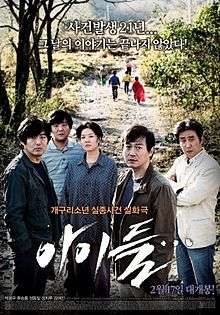
Child
Biologically, a child (plural: children) is a human between the stages of birth and puberty. The legal definition of child generally refers to a minor, otherwise known as a person younger than the age of majority.
Child may also describe a relationship with a parent (such as sons and daughters of any age) or, metaphorically, an authority figure, or signify group membership in a clan, tribe, or religion; it can also signify being strongly affected by a specific time, place, or circumstance, as in "a child of nature" or "a child of the Sixties".
There are many social issues that affect children, such as childhood education, bullying, child poverty, dysfunctional families, child labor, and in developing countries, hunger. Children can be raised by parents, by fosterers, guardians or partially raised in a day care center.
Legal, biological, and social definitions
The United Nations Convention on the Rights of the Child defines child as "a human being below the age of 18 years unless under the law applicable to the child, majority is attained earlier". This is ratified by 192 of 194 member countries. In U.S. Immigration Law, a child refers to anyone who is under the age of 21.

Children (2011 film)
Children... (Hangul: 아이들; RR: Aideul) is a 2011 South Korean film, based on a true story about an unsolved murder case.
Plot
On March 26, 1991, five boys went to Mount Waryong to catch frogs but never returned. Eleven years later, police discover the bodies of the five children, and television producer Kang Ji-seung tries to solve the mystery.
Cast
Release
The film was released on February 17, 2011 and netted a total of 1,867,736 admissions nationwide.
References
External links

Children (David Murray album)
Children is the eighth album by David Murray to be released on the Italian Black Saint label. It was released in 1984 and features performances by Murray, James "Blood" Ulmer, Don Pullen, Lonnie Plaxico and Marvin "Smitty" Smith.
The album was identified by Chris Kelsey in his Allmusic essay "Free Jazz: A Subjective History" as one of the 20 Essential Free Jazz Albums.
Reception
The Allmusic review by Scott Yanow awarded the album 4 stars stating "The somewhat noisy performances are pretty spontaneous and, thanks to Pullen's rhythmic style, a little more accessible than one might expect, despite being quite adventurous.".
Track listing
- Recorded at Vanguard Studios, NYC, October 27 and November 15, 1984
Personnel
FTW
FTW may refer to:
Places
- Fort Worth Intermodal Transportation Center, by Amtrak code
- Fort Worth Meacham International Airport, by IATA code
Music
Other

47th Flying Training Wing
The 47th Flying Training Wing (47 FTW) is a United States Air Force pilot training wing based at Laughlin Air Force Base, near Del Rio, Texas. It is one of five pilot training units in the Air Force's Air Education and Training Command which conducts joint specialized undergraduate pilot training for the United States Air Force, Air Force Reserve, Air National Guard and allied nation air forces utilizing the T-38C, T-6A and T-1A aircraft.
Units
Aircraft flown
History
Cold War
Light bombardment operations in the United States
On 28 July 1947, the 47th Bombardment Wing was established as part of the Army Air Forces' implementation of the wing base reorganization, which combined tactical and support elements on its bases into a single wing. The wing became active on 15 August 1947 at Biggs Field, Texas, with the 47th Bombardment Group as its operational unit. On 1 February 1948 Biggs was turned over to Strategic Air Command, forcing a relocation of the wing to Barksdale Air Force Base, Louisiana in November. In the fall of 1948 North American B-45 Tornado bombers began to be delivered to the wing, which became the first in the Air Force to fly the aircraft. However, the B-45As were not truly operational, because they lacked both fire control and bombing equipment.

71st Flying Training Wing
The 71st Flying Training Wing (71 FTW) is a United States Air Force unit assigned to the Air Education and Training Command Nineteenth Air Force. It is stationed at Vance Air Force Base, Oklahoma where it also is the host unit.
The mission of the Wing is threefold: Produce pilots for U.S. Air Force, U.S. Navy, U.S. Marine Corps, and allied nations as directed. Second, prepare forces to support mobility taskings and deploy when directed. Third, provide support to, and execute mission directives. The 71 FTW is the only Air Force unit to conduct joint specialized undergraduate pilot training for officers of the Air Force, Navy, Marine Corps, Air Force Reserve, Air National Guard and the air forces of several allied countries.
The unit has a long and decorated history. The group's World War II predecessor unit, the 71st Reconnaissance Group operated primarily in the Southwest Pacific Theater flying reconnaissance missions. It was awarded the Philippine Presidential Unit Citation for its role in the liberation of the Philippines during 1944–1945. During the Cold War, the 71st Strategic Reconnaissance Wing (Fighter) was a part of Strategic Air Command. The wing performed strategic reconnaissance and also tested a technique for launching small RBF-84 aircraft from GRB-36 bombers to extend the range of photographic reconnaissance and fighter escort. The testing ended in 1956, but the wing continued strategic reconnaissance until inactivated on 1 July 1957.
Podcasts:

